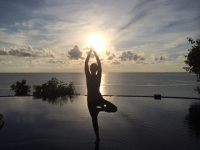The Ujjayi breath – how to breath during an Ashtanga yoga practice !
The way of breathing during a yoga practice is very important. Our teachers used to say that breathing correctly will improve significantly our practice. We could see that after having practicing Ashtanga yoga daily for 2 months, our practice has improved, thanks to learning about how to breathe. The breathing indeed helps the body to go deeper in the practice and to still the mind.
In Sanskrit, the control of the breath is called Pranayama. “Prana” means breath or vital life energy and “Yama” means control. Practicing Asana (postures) and Pranayama (control of the breath) the Prana is brought and stored into the body, increasing the vitality. The Prana mainly flows through the nadis which are nerves channels readjusting the nervous system and stilling the mind. There are over 50 different techniques to control the breath such as Kalabati breath, the Agni breath (breath of fire), ect. These different ways of breathing can be categorized under four different purposes: sensitizing, balancing, vitalizing and tranquilizing.
But let’s start with the most important breath to have during a yoga practice. It is the Ujjayi breath.
The Ujjayi breath is used while practicing yoga but can also be used at any time of the day to get our mind focused, to release the stress, to vitalize the body.
During the practice Ujjayi breath gives different results such as:
– generate heat and purify the body
– the sounds of the breath keep the mind focused
– it is an indicators of the quality of the practice, an Ujjayi breath should be smooth and relaxed
If any discomfort is experienced, it is advise to lower the ratio of breathing or not to force too strong.
How to practice:
1. Sit in a comfortable pose or lay down in Savasana.
2. Take a deep inhale and a deep exhale and start doing to sound “saaa” on the inhale and “haaa” on the exhale. Now after a try, keep the mouth closed activating these 2 sounds. The sound of the breath resonates in the nostril, palate and throat. Only when the sound is at the back of the throat, it resonates in the chest cavity giving the diaphragms full range of movement. The inhalation and exhalation should be balanced becoming both soft and steady.
For more information this video on YouTube will with Kino MacGregor will give you a great overview ! Kino is an international yoga teacher, author of two books and producer of six Ashtanga Yoga DVDs. We love the way she teaches which is easy, fresh and motivating. Enjoy your practice !
“The depth of Ujjayi breath is a good indicator of the quality of the practice. Ex: it is an indicator you have gone too far into the pose when Ujjayi is compromised” Hatha Yoga Pradipika












Pingback: Boost your energy with Sun Salutations A and B | PilotFish Traveling around the world, discovering South Asia and South America in a year